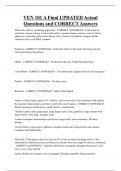VEN 101 A Final UPDATED Actual
Questions and CORRECT Answers
What's the order to evaluating grapevine? - CORRECT ANSWER✔✔- Look at leaves:
serrations, sinuses, lobing. Look at leaf surface: smooth, bumpy, concave, convex. Hairs:
glaborous, cobwebby, pubescbent, downy, felty. Clusters: shouldered, winged, double
clustered, loose, well filled, compact.
Peduncle - CORRECT ANSWER✔✔- Holds the cluster to the trunk. Develops into the
rachis and ends in the pedicel.
Oblate - CORRECT ANSWER✔✔- Flattened at the pole. Think Palomino berry.
Count Shoot - CORRECT ANSWER✔✔- Two shoots that originate from the two bud spurs
Pedicle - CORRECT ANSWER✔✔- The berry stem
Reniform - CORRECT ANSWER✔✔- kidney bean shaped
Name 4 of these large regions of V. vinifera, and list two leaf or fruit characters that typifies
the regional characteristics, and list a variety from each region. - CORRECT ANSWER✔✔-
Western European: small leaves, small clusters, round berries
Middle Eastern: table grape types, large floppy leaves, thin, glabrous. Large clusters with
larger berries. Very large, irregular teeth.
Eastern European: Intermediate sized leaves, larger teeth, more tomentum. The hairy
Italians.
North African: Large leaves, glabrous, irregular teeth med to large berries and clusters.
Carignane and Tempranillo.
Name the 3 Vitis species that were used in 95% of the rootstock breeding and list 2 key
characteristics they possess that can help you estimate how they might be used as a rootstock.
- CORRECT ANSWER✔✔- rupestris: phylloxera resistantant, drought tolerant (not very),
easy to root, virus tolerant
riparia: phylloxera resistant, easy to propagate, drought suceptible, hasten maturity.
, berlandieri: Lime tolerant, phylloxera resistant. Hard to root. Drought tolerant.
Name 3 different Vitis species (other than those you listed in Question 3) that have been used
in rootstock breeding over the last 40 years and list why they were used in breedin -
CORRECT ANSWER✔✔- Champinii: limestone resistant. High nematode resistance,
moderate phylloxera. Difficult to root.
Longii/Acerfolia: Good drought tolerance and nematode, easy to root.
rotundifolia: Muscadine grapes. Resistant to most pests.
Rank these cultivars in the order in which they will ripen (early, midseason or late): Merlot,
Cabernet Sauvignon, Pinot noir, Sauvignon blanc and Syrah - CORRECT ANSWER✔✔-
Sauvignon Blanc, Pinot Noir, Merlot/Syrah, Cabernet Sauvignon
25 acres of deep sandy (NEMATODE) river bottom soil in the Monterey Valley, was a
vegetable crop production area, 10-15 inches of rainfall (above 20 you can dry farm)/yr but
high water table from Salinas River (region II) - CORRECT ANSWER✔✔- Soil-bourne pest
problems: suspect nematode - vegetables
Rootstock choice: want moderate vigor with nema resistance - 101-14, 5C, 5BB, 1616C
Grape cultivar: Cool climate red or white Chard, PN
2 acres of Rutherford bench (most expensive soil in Napa) deep clay-loam soil, current
vineyards yields have been chronically low, and leaves have chlorosis along the veins in the
Fall, ≈30 inches of rain/yr (region III) - CORRECT ANSWER✔✔- Soil-bourne pest
problems: Fanleaf (chronically low, chlorosis)
Rootstock choice: O39-16
Grape cultivar: Cab Sauv, Merlot, Can Franc
10 acres in Paso Robles, shallow limestone hillside, very limited rainfall (<12" or 30 cm)
(Region III to IV) - CORRECT ANSWER✔✔- Soil-bourne pest problems: Limestone,
drought and salt tolerance needed
Rootstock choice: Ramsey, 110 R, 140 Ru
Grape cultivar: Cab, Syrah, rhone red and whites
10 acres in the Anderson Valley, Mendocino Co., abandoned vineyard on the valley floor,
cool foggy region with a late budbreak and relatively short growing season, 40 to 50 inches




